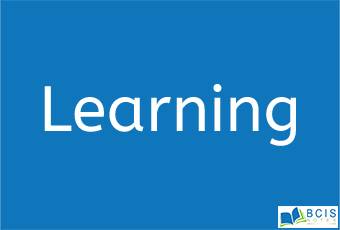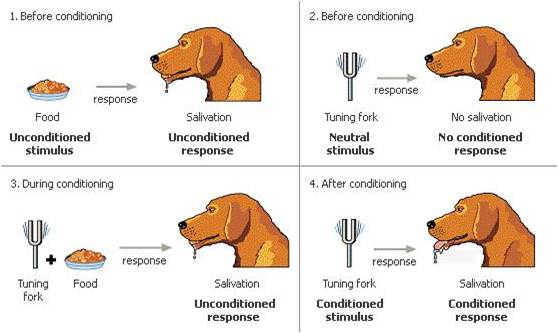
Learning in OB
Concept:
Learning in OB is the acquisition of knowledge, skills and behavior through study or experience. Learning is a universal and continuous process not limited to any particular age, sex, race and culture etc. It is purposeful and goal oriented. It would be difficult to learn without any purpose. Learning in OB range from simple to complex.
Components of Learning in OB:
- Change
- Permanency
- Behavior
- Experience
Steps in Learning:
- Stimulus
- Response
- Motivation or drive
- Reward
Significance of learning:
- Human Resource Development
- Behavioral Change
- Increased Performance
- Technological Adaptation
- Change Management
- Multiple Impacts
- Relationship between learning and job performance
Factors influencing learning in OB:
Motives, Stimuli ,Response ,Reward, Reinforcement ,Retention, Repetition, Feedback.
Major models of learning –
- Classical conditioning,
- Operant conditioning,
- Cognitive learning and
- Social learning.
Classical conditioning:
The theory of classical condition was postulated by Ivan Pavlov. Conditioning is the process of learning associations by linking of two events that occur together, usually between a stimulus and a response or between two stimuli. He developed the theory on the basis of the experiments on dog.
Ivan Pavlov (1927) in his studies fed meat power (UCS) to the dog while a bell (CS) was ringing. The meat power caused the dog to begin salivating (UCR).
The several presentations of CS followed by Us and strengthening of the behavior were termed as reinforcement by Pavlov. After several-reinforcement when the sound of the bell alone was presented, the dog salivated (CR). The classical conditioning phenomena had been established.
The experiment process(with dog)

Conditioning Processes: Basic principles
- Acquisition
- Extinction
- Spontaneous recovery
- Generalization
- Discrimination
1. Acquisition:
It is the training stage during which the animal is learning the stimulus-response relationship.
2. Extinction:
If the conditioned stimulus (CS) is presented alone a number of times without the food, the magnitude of the conditioned response (CR) of salivation begins to decrease.
This process with the gradual disappearance of the conditioned response (CR) on disconnecting the S-R association is called extinction.
3. Spontaneous recovery:
Spontaneous recovery refers to the sudden resurfacing of a conditioned response, which was previously extinguished due to a lack of association between a conditioned and unconditioned stimulus.
4. Stimulus generalization:
The tendency of stimuli similar to a conditioned stimulus (CS) to evoke a conditioned response (CR) is called stimulus generalization.
5. Stimulus discrimination:
The process by which organisms learn to respond to certain stimuli but not to others.
Applications of Classical conditioning:
- Treatment of a behavior problem
- Treatment of phobias
- Learning taste (Aversion and Preparedness)
- Study of sensory capacity
Edward Thorndike was the first psychologist to use operant conditioning. It states that behavior is a function of its consequences. It is a type of conditioning in which desired voluntary behavior leads to a reward or prevents a punishment. Operant conditioning is a process by which a response become more or less likely to occur, depending on its consequences.
Operant conditioning is the term derived from the word operate. When our behavior operates in the outside world, it produces some kind of effort for us and these effects determine whether we continue to engage in that behavior. It involves reinforcement for desired behavior as a central process in learning. If the consequences are rewarding, the response will be repeated and will grow in strength. This model attributes learning to response-stimulus.
It is also known as cognitive behavioral theories focus on both external environment condition and internal cognitive process in determining learning process. Learning is guided by cognitive process like intelligence , thinking, perceiving, and future expectation. It prioritizes that key to learning and changing is the individual’s cognition. Cognitive learning focuses on the role of perception and understanding play in a more complex form of learning. The psychological result of perception and learning and reasoning. S-R associations can only explain simple forms of learning and not complex forms of learning.
Two renowned cognitive theories of learning are social learning theories and insightful learning theories.
Social learning theory:
The theory was proposed by Albert Bandura. The basic concept of this theory is that human beings learn by merely observing or imitating the behaviors of others. Bandura believed that much of our learning comes from watching models like parents, teachers, peers, motion picture,s and television performance. Bandura criticized the behavioristic approach of learning by arguing that the experiments conducted in animals can not be generalized to human beings.
Behavior modification:
Behavior Modification refers to the alternation of behavioral patterns through the use of reinforcement. It is the application of reinforcement concepts to individuals in the work settings. It is based on the principles of operant conditioning. It is the approach that replaces undesirable behaviors with more desirable ones through positive or negative reinforcement. Its main purpose is to improve performance. Steps in behavior modification are:
1.Identify critical behaviors
2.Develop baseline data
3.Identify behavioral consequences
4.Intervention strategy
5.Evaluate performance improvement
You may also like Introduction to OB

Leave a Reply